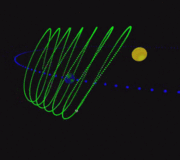2002 AA29
|
|
| Discovery A (http://cfa-www.harvard.edu/iau/lists/NumberedMPs.html) | |
|---|---|
| Discoverer | LINEAR |
| Discovery date | January 9, 2002 |
| Alternate designations | B (http://cfa-www.harvard.edu/iau/MPDes.html) |
| Category | Aten asteroid |
| Orbital elements C (http://asteroid.lowell.edu/) Epoch November 22, 2002 (JD 2452600.5) | |
| Eccentricity (e) | 0.012 |
| Semi-major axis (a) | 149.588 Gm (1.000 AU) |
| Perihelion (q) | 147.735 Gm (0.988 AU) |
| Aphelion (Q) | 151.442 Gm (1.012 AU) |
| Orbital period (P) | 365.222 d (1.00 a) |
| Mean orbital speed | 29.784 km/s |
| Inclination (i) | 10.739° |
| Longitude of the ascending node (Ω) | 106.849° |
| Argument of perihelion (ω) | 91.594° |
| Mean anomaly (M) | 225.947° |
| Physical characteristics | |
| Dimensions | ~0.06 km |
| Mass | ~2.3×108 kg |
| Density | 2 ? g/cm³ |
| Surface gravity | ~0.000 017 m/s² |
| Escape velocity | ~0.000 032 km/s |
| Rotation period | ? d |
| Spectral class | ? |
| Absolute magnitude | 24.08 |
| Albedo | 0.1 ? |
| Mean surface temperature | ~279 K |
Asteroid 2002 AA29 (also written 2002 AA29) is a near-Earth asteroid discovered in January 2002 by the LINEAR asteroid survey. The asteroid follows a "horseshoe orbit" that makes it come near the Earth every 95 years as it follows Earth's orbit around the Sun and will, in nearly 600 years, appear to orbit the planet. It measures about 60 metres across.
On January 8, 2003, the asteroid came within approximately 5.9 Gm (3.7 million miles) of Earth, its closest approach for almost a century.
Richard Gott and Edward Belbruno from Princeton University have speculated that 2002 AA29 might have formed together with Earth and Theia, the postulated planet that, according to the Giant Impact theory collided with Earth in its early history.
The orbit of the asteroid makes it relatively easy to retrieve rock samples and bring them to Earth for analysis.
External links
- MPEC 2003-A17 (http://cfa-www.harvard.edu/mpec/K03/K03A17.html)
- Earth coorbital asteroid 2002 AA29 (http://www.astro.uwo.ca/~wiegert/AA29/AA29.html)
| The minor planets |
| Vulcanoids | Main belt | Groups and families | Near-Earth objects | Jupiter Trojans |
| Centaurs | Trans-Neptunians | Damocloids | Comets | Kuiper belt | Oort cloud |
| (For other objects and regions, see: Binary asteroids, Asteroid moons and the Solar system) |
| (For a complete listing, see: List of asteroids. For pronunciation, see: Pronunciation of asteroid names.) |

